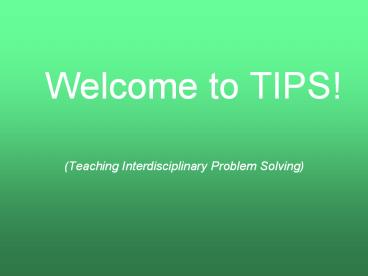(Teaching Interdisciplinary Problem Solving) PowerPoint PPT Presentation
1 / 15
Title: (Teaching Interdisciplinary Problem Solving)
1
Welcome to TIPS!
- (Teaching Interdisciplinary Problem Solving)
2
History of TIPS
- A U.S. Department of Education Technology
Innovation Challenge Grant. Awarded in 1999. - In 5th Year of a 5 year grant. One year extension
for 2004-2005 school year. - Awarded to Bronx HS district.
- About 600 teachers have participated
- Goal to integrate technology into the curricula
through analysis of public policy and the study
of Supreme Court cases - Each teacher receives about 80 hours of
Professional Development.
3
TIPS Staff
- Ira Gelernter- Co-Director (Bronx)
- Fred Fisher- Staff Developer
- Art Fortin- Staff Developer
- David Gelfand- Staff Developer
- Kate OHara-Staff Developer
4
TIPS and Professional Development
- Use of Technology
- Laptop computers for instructional use
- LCD projectors for classroom use
- Workshop training in general technology-
After school and during four
full-day programs
5
TIPS and Professional Development-(2)
- Non-Technical
- Use of TIPS Techniques in the classroom
- Conlaw
- Public Policy Analysis (PPA)
- Science PPA
- Global History PPA
- International PPA
- U.S. History PPA
6
TIPS and Professional Development-(3)
- These techniques can be used in
- Computer labs.
- Classrooms with or without an internet
connection. - As paper-based research that doesnt require
computer or internet access (some access is
considered desirable)
7
TIPS and the Internet
- Seeks to have students identify public problems
and study possible solutions- it also studies
solutions tried in the past. - The TIPS Website is the portal most students use
to get started in the program. - The TIPS Website
8
Parts of TIPS
- Public Policy Analyst (PPA)
- A structured study of public problems with the
objective of developing suggested solutions and
testing their validity. - ConLaw
- The study of Supreme Court Cases and their impact
on peoples lives.
9
Conlaw
- A related part of TIPS that studies Supreme Court
Cases. - A process has been developed to study and
understand the nature of a particular court case
and how it has impacted society.
10
The Public Policy Analyst
- The other major part of TIPS.
- Students are asked to analyze a public problem
or from the past. (PPA)- (SPPA) - They then develop a policy to address that
problem and analyze it as well. - For historical events the process involves
looking at what policies were developed and
analyzes their effectiveness. (GHPPA)-(USHPPA)-(IP
PA)
11
WebQuests
- The six main sections of a TIPS WebQuest
- The Introduction
- Orients students and captures their interest.
It gives an overview of the activity. The
introduction (and the entire WebQuest) is written
in the second person (You or Your group), for
it is directed to your students. Some creative
WebQuests use a scenario that is first presented
in the Introduction. Be sure to define the
context and location of your WebQuest in the
Introduction.
12
The Task describes the general goals or
objectives of the WebQuest. It is any product(s)
that students are expected to produce such as a
PowerPoint, an oral presentation on an analysis
of a Supreme Court case using CompuLEGAL, a
storyboard that depicts the development of new
policies to deal with air pollution by using the
Public Policy analysis, etc.
13
The Process explains strategies students should
use to complete the task(s) that have been stated
in section two. The exact links for the various
six steps of the PPA process are used or the
particular link to the CompuLEGAL case being
studied.
14
The Resources are the websites and documents
students will use to complete the task. Also,
other website links related to the topic may be
included. The Evaluation measures the results
of the activity. Usually, it should contain a
rubric that clarifies the teachers criteria for
evaluating the various tasks or products that the
student must produce. It also includes specific
state/city standards from at least two academic
disciplines (since TIPS is interdisciplinary).
15
The Conclusion sums up the activity and
encourages students to reflect on its process and
results. It can also be used to introduce the
next WebQuest.

